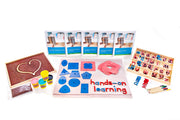I’ll never forget the joy in my son’s eyes when he shouted out- “Mom! Four quarters make one dollar, now I get this fraction thing!” It’s that moment of realization and understanding we absolutely love as homeschool parents. The moment when we realize our kids ARE getting it and we CAN thrive at home educators.
For many children, making the connection between all those slices of pizza being the same as one whole pie is easy. Until you write it down on paper and take away the word pizza.
Or the child who can easily grab half a sandwich… but then stares at you like a deer in the headlights when you ask them to find the ½ written out.
It can be hard to translate real life into numbers on a paper- or even visual representations.
Homeschool parents are often frustrated by fractions. They see their children interacting with the “real life” examples and struggling to translate that over. Or parents worry the concept will be too difficult or confusing for their children. These are legitimate concerns. Yet they shouldn’t stop you from teaching this important skill. We’re here to give you tips not only on when to teach this basic math skill but how to teach them in a way that won’t bring any tears or frustration.
The Best Way to Teach Fractions to Homeschoolers
The team at ShillerLearning discovered there was a gap in the fractions curriculum available to home educators. We saw this gap across all teaching modalities, especially among the Montessori-based home educators. Nothing truly hands-on existed for parents. We heard again and again from parents with no idea what to do. Our hearts broke for kids who cried over boring worksheets that didn’t make sense.
Something had to change
We created our Fractions Kit for exactly this purpose. It’s an open-and-go, 100% multisensory and engaging curriculum. You’ll discover it’s modeled just like our popular Math Kits I and II. We’ve used the same Montessori-inspired language, lesson structure, and manipulatives to bring this important basic math concept to life.
No more boring worksheets. Your children will use colorful pieces, real materials from home, and more. They’ll not only learn what a fraction is but why they matter. Your students will learn how to identify them in the real world. With joy and ease, they’ll complete equations, learn about denominators, and more. You will love not having anything to prepare but opening a book. Students will love learning and have a blast doing it. We’ve even heard from families whose children choose to work on this kit in their free time because they enjoy it so much.
When Should I Introduce Fractions??
Most children are ready around 2nd grade. However, fractions can be introduced from the time your children are very young. Give concrete examples in real life anytime you’re able. Count coins with them so they can see how 4 quarters, 10 dimes, 20 nickels, and 100 pennies all = 1 whole dollar. Cut up their sandwich and name the quantities. Discuss the percentage of sales and which fraction they match up to. If they have real-life situations in their brains already, they’ll be less intimidated.
Here at ShillerLearning, we don’t believe in putting an age limit on when children should be learning something. Isn’t part of what we love about the Montessori Method that children learn on their own pace? We have young children working in our kit, all the way through teens. We’ve even had a few adults work through the kit to help fill in gaps in their own education!
If you don’t give age ranges, how do I know when to start my child on the kit?
This is a question we’re asked all the time. It can be confusing to not get a cut and dry answer. For most children, fractions are added in Kit I along with Book 2 or 3. Sometimes families will wait until they’re done with Kit I, others add the kit in alongside Kit II, Book 4. The overwhelming majority introduce fractions at Kit I Book 2 or 3.
Options and Tips for Introducing the Fractions Kit:
- Give your student a choice when they’d like to do fractions and how often.
Your student may want to work once a week on fractions, drop their current book, for now, to focus exclusively on fractions, rotate the kit book in at their leisure, or complete the entire book after book 3. These are only a few suggestions, your student may choose when they’d like to work on them
- At least through fourths needs to be introduced by the end of the second review test in book 3. Your student will need this information to move on to the next section.
- Foundational knowledge of division can be helpful, but not necessary
- As you progress through the Kit, you’ll eventually hit a point where you need to have completed specific lessons in our Math Kits to proceed.
The Kit will last for several years! In general, it’s not something that’s worked all the way through because of this.
Want some additional help with this foundational & basic math skill? Love “real life” learning, games, crafts, etc? Make sure to grab our FREE Fraction Activity Pack for additional lessons. You’ll find lessons designed for all ages- toddlers through teens. As always, they’re full of the best of Montessori-inspired games, crafts, lessons, works, and more.






